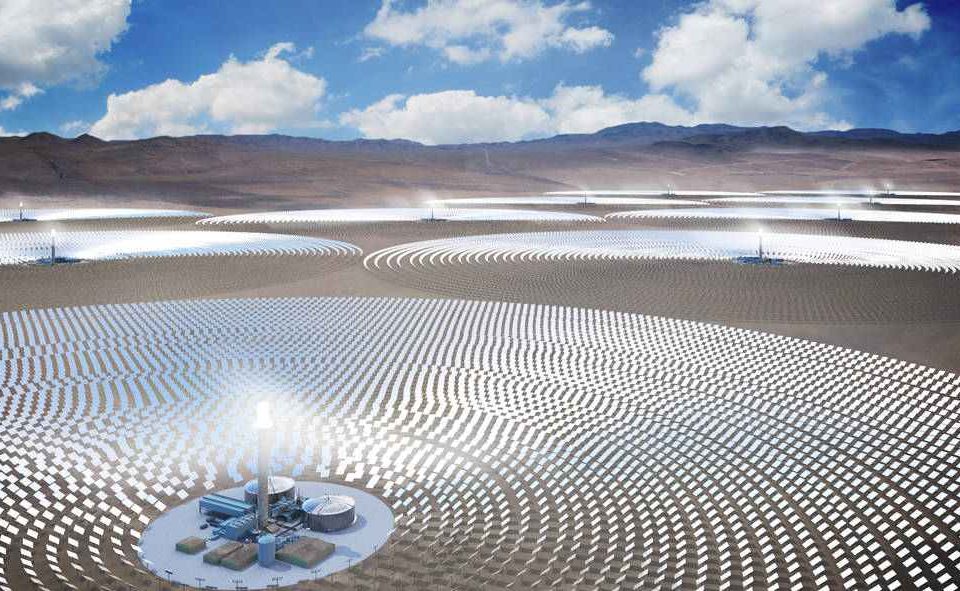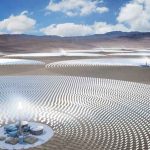This $1 billion boondoggle solar plant project was obsolete before it ever went online….It was over before it even began

The Crescent Dunes Solar Energy Project is one of the most popular solar project failures of the 20th century. Developed by SolarReserve and owned by Tonopah Solar Energy, the Crescent Dunes project is a 110 megawatt (MW) plant located near Tonopah, about 190 miles (310 km) northwest of Las Vegas. Once constructed, it was supposed to power up to 75,000 homes during peak electricity periods.
The project was anticipated to cost less than $1 billion and was backed by a $737 million in U.S. government loan guarantees. Crescent Dunes was the first concentrated solar power (CSP) plant with a central receiver tower and advanced molten salt energy storage technology from SolarReserve. According to Bloomberg, a combination of terrible management and simple technological advancement turned the plant into a dinosaur. So, what really went wrong?
It all started in 2011 when the $1 billion solar plant was approved to generate approximately 500,000 megawatt hours annually of clean, renewable electricity, enough to power 75,000 homes during peak electricity periods. The plant later suffered several technical problems, and failed to deliver its intended 50% capacity factor, only achieving about a 20% capacity factor in 2018, and eventually closed in 2019.
SolarReserve is a venture-backed renewable energy startup, focuses on advanced solar thermal storage technology. The startup was founded in 2007 by Kevin Smith to solve two of the fundamental barriers of renewable energy: scalability and storage. Unlike hydroelectric, geothermal, biomass, and other renewable energy technologies that use limited renewable fuel sources.
Its power plants draw their heat from the sun – earth’s ultimate source of clean energy. Unlike wind and photovoltaics, SolarReserve’s power plants deliver power whenever it is needed, either 24 hours per day or only during “peak” demand. By overcoming these two key barriers, SolarReserve was able to enable utility-scale, clean, renewable electricity generation.
As of May 2015, the startup has already invested $2.8 billion in developing and securing long-term power contracts for 482 megawatts (MW) of solar projects, with a development pipeline of more than 6.6 gigawatts (GW) globally. In 2011, the startup embarked on another $1 billion Crescent Dunes Solar Energy Project near Tonopah, Nevada. The project was to be the biggest solar plant of its kind. Citigroup Inc. and other financiers invested $140 million with its developer, SolarReserve Inc. Steven Chu, the U.S. Department of Energy secretary at the time, offered the company government loan guarantees, and Harry Reid, then the Senate majority leader and senior senator from Nevada, cleared the way for the company to build on public land, according to a report from Bloomberg.
As Bloomberg describes it, “the Crescent Dunes solar plant looks like something out of a sci-fi movie with ten thousand mirrors form a spiral almost 2 miles wide that winds around a skyscraper rising above the desert between Las Vegas and Reno.” The operation soaks up enough heat from the sun’s rays to spin steam turbines and store energy in the form of molten salt. So, what caused a once high-flying startup to shut down its $5 billion Crescent Dunes solar plant in April 2019?
Obsolete Technology and Mismanagement
SolarReserve’s rescent Dunes solar plant was primarily based on Concentrated Solar Power (CSP) and Photovoltaic (PV) technologies. With solar energy witnessing new innovations, concentrated solar became unsustainable and too expensive to maintain. The steam generators at its solar plant require custom parts and at least 12 people to conduct regular maintenance and keep the plant running. The problem is further compounded with cheap solar coming from new Nevada photovoltaic solar farm and China. We will talk about China later in the article.
So, for example, the average production cost of concentrated solar thermal energy is much higher than other renewable resources. SolarReserve’s power cost Nevada about $135 per megawatt-hour, compared with less than $30 per MWh today at a new Nevada photovoltaic solar farm. Though during the past few years, the average cost has dropped to $0.20/kWh. Still, the costs are high as in comparison, the average production cost of solar PV is in the range of $0.05 to $0.10/kWh.
The beginning of the end?
CSP was all the rage a decade ago and everything was going well for SolarReserve. CSP technology uses concentrated sunlight to create steam and drive turbines. However, as any technologist will tell you, today’s emerging technology is tomorrow’s legacy. Ten years later, CSP suffers the same fate as many other emerging technologies before it and fell prey to the falling costs of crystalline silicon solar.
With Solar energy witnessing new innovations, many solar companies are experimenting a more efficient and cost-effective ways to produce solar energy by making technological breakthroughs. Especially, Chinese solar companies are dominating the solar market by providing low-cost energy using advanced methods. These new innovations may potentially make concentrated solar technology outdated. In a paper titled “The Dragon Awakens: Will China Save or Conquer Concentrating Solar Power?,” the authors from Renewable Energy Policy Group at the Institute for Environmental Decisions at ETH Zürich, said: “The outlook for CSP was bleak and its very survival as a commercial technology seemed to hang in the balance.”
On January 31, 2019, citing the Nevada Bureau of Land Management, the Las Vegas Review Journal reported that SolarReserve withdrew its application to build the $5 billion concentrated solar array on federal land. The $5 billion CSP project would have included 100,000 mirrors and 10 towers that would have been able to store the sun’s energy and generate power after dark. The decision came after SolarReserve already built one concentrated solar array tower outside of Tonopah. The $1 billion, 110-megawatt Crescent Dunes Solar Energy Plant began delivering power to NV Energy in 2015.

In 2019, SolarReserve’s Concentrated Solar Power technology struggled to stay online after going commercial almost four years ago. CSP is not the only problem, SolarReserve has other concerns. The company faced problems from conservationists and Native American groups who own the areas where SolarReserve operate its plants. Per Las Vegas Review Journal, some energy analysts raised concerns about the project and maintenance costs associated with concentrated solar projects. Others worried about the project’s potential impact on wildlife and Nevada’s landscape.
Finally, in October 2019, SolarReserve filed suit against the LLC which owns Crescent Dunes and the U.S. Department of Energy. The lawsuit claims that DOE, which provided a loan guarantee for Crescent Dunes, is stacking the board and trying to push out its sole director,” according to another report from PV Magazine.
In the end, it all comes down to efficiency, innovation. SolarReserve can no longer live its past glory in the face of cheap and efficient solar panels. There is still hope of the startup of its willing to develop and embrace newer and better technologies.




